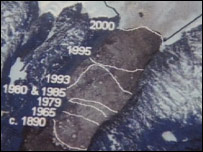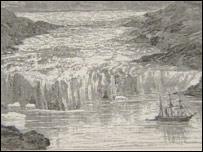Then as the icebergs rip away from the margin of the ice-sheet they
plunge into the grey waters of the Atlantic with a roar that echoes
around the mountains.
The only way to reach the ice-sheet is by helicopter - a spectacular
flight through remote fjords and the jagged blue-white rubble of the
ice.
We travelled with Danish scientist Carl Boggild of GEUS, the
Geological Survey of Denmark and Greenland.
For the past few years he has been managing a network of 10 automatic
monitoring stations and his first results are alarming - the edges of
the ice-sheet are melting up to 10 times more rapidly than earlier
research had indicated.
In 2001 NASA scientists published a major study based on observations
by satellite and aircraft.

Scientists have traced the retreat of the Sermilik glacier
|
It concluded that the margins of the Greenland ice-sheet
were dropping in height at a rate of roughly one metre a year.
Now, amid some of the most hostile conditions anywhere on the planet,
Carl Boggild and his team have recorded falls as dramatic as 10 metres a
year - in places the ice is dropping at a rate of one metre a month.
The glacier we visited - the Sermilik glacier in southern Greenland -
is so volatile that one automatic monitoring station was lost into a
yawning crevasse.
Between a maintenance visit in May and our visit this
month, new cracks had opened up in the icy surface and we had
to help shift one of the devices to a safer position.
Engravings from the late 19th Century show how the glacier once
reached far into the ocean and satellite pictures highlight how the
retreat has accelerated - the glacier dropping an astounding 150 metres
in the last 15 years.
The latest data shows the melting picking up even more speed.
Heating up?
A vicious wind whipping across 2,000 kilometres of solid ice - the
length of the Greenland ice-sheet - chilled us as we filmed.

A hundred years ago the glacier reached into the sea
|
But the feeling of cold was ironic - it is the rise in
air temperatures recorded here that is at least partly responsible for
the sudden acceleration of the melting.
Dr Boggild and his colleagues, studying the physics of how the air
and ice relate, conclude that as much as 55% of the melting is
attributable to warming in the air.
He is cautious to avoid blaming climate change too readily: "Maybe if
we look back after 50 years and see how temperatures have risen, then we
can call it climate change."
Sea level rise
Dr Boggild is all too aware of how easily he could be accused of
jumping onto a climate change bandwagon.
But he is adamant that the results he has gathered so far are
reliable.

Potatoes are growing for the first time in centuries
|
"We can say for certain that the rate of melting has
increased and we can say for certain that the height of the ice-sheet is
falling, even allowing for increased ice-flow.
"There is no doubt that something very major is happening here."
As we speak, he checks the instruments on the automatic station. A
large range of data is collected and transmitted via satellite to
Copenhagen every six hours.
For the first time, scientists should have a long-term, on-the-ground
view of the changes taking place here.
Just before we leave, there is another roar as more icebergs crash
into the ocean
Many more icebergs falling into the sea will cause two things to
happen - the sea-level will rise and the injection of freshwater could
disrupt the ocean currents, including the Gulf Stream.
What happens in this remote barren land has the potential to affect
us all.
